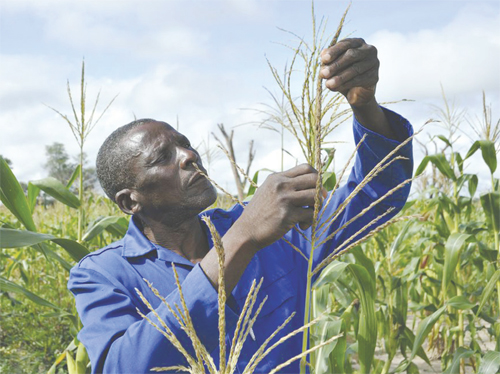STEVE FELTONCHRISTOPHER Muswalali has a bible handy. He’s a lay preacher and sub-induna in Sikweke, one of the many small villages you pass by on the way to Zambezi’s top tourist lodges.
He also has a shotgun near to hand in case the elephants come raiding again. I ask him if he loves God’s creatures and he says yes, with a twinkle in his eye, but not near his crops.
Here’s the conundrum: wildlife brings tourists to Zambezi, where you can see elephants, hippos and even lions.
Impalas are in abundance among the kudu and zebra. It’s a piece of paradise. Tourism brings jobs; some of Muswalali’s neighbours work at Namushasha and Camp Kwando, and income from the lodges goes to conservancies, which spend the money on community projects.
All well and good, says Muswalali, but he doesn’t work for a lodge and the elephants eat his crops. He is a serious farmer with five hectares of millet and maize under cultivation. He sleeps by the crop and is quite prepared to fire a warning shot if the elephants come again. Last year he lost half a hectare. He says you know when the grey giants are coming. “You hear the rumbling in their bellies.”
Just down the road, freshly tarred by a Chinese contractor, is Sijwa, the training centre set up by conservation NGO Integrated Rural Development and Nature Conversation (IRDNC) and supported by the MCA. A workshop is led by Mike La Grange, a chubby and cheerful Zimbabwean, and an expert on elephant behaviour. The workshop is for farmers like Muswalali. La Grange wants to hear about local farmers’ experience, and he wants to bring some new ideas.
Elephants, as we all know, never forget. La Grange has something to say about elephants and their memory.
It’s all about competing land uses. Zambezi Region lies in the centre of KAZA, the Kavango Zambezi Transfronter Conservation Area. Five countries are involved: Angola, Botswana, Namibia, Zambia and Zimbabwe. Historically, elephants moved across the borders without hindrance, but population growth, agriculture, cattle ranching and fences have put a stop to that. Thousands of elephants are effectively penned up in the Chobe National Park in Botswana, causing large scale damage to trees.
KAZA is an attempt to redress the balance, and not just for elephants. If wildlife can roam freely through the national parks, game areas, conservancies and farm lands of the five countries, tourism will benefit significantly. But if you take the fences down, says La Grange, that doesn’t mean the elephants will automatically move, and he gives an example.
La Grange’s main work is game capture. He remembers when a fence was removed between Kruger National Park in South Africa and Limpopo Park in Mozambique. The idea was that elephants would move across the border to find fresh browse.
But they stayed obstinately put. So La Grange and his team darted 50 elephants and moved them to Limpopo where they were released. After a while they returned to Kruger, but later still moved back to Limpopo, taking 1 000 elephants with them.
KAZA aims to take down fences, and to create wildlife corridors for elephants and game to move freely again. It also plans to assist farmers to cultivate away from the corridors, and to protect their crops with strategies that work with the elephants memories.
A key strategy is chilli fences: strands of wire around the fields with chilli-impregnated cloths hanging from them. Elephants don’t like chilli, and to ram the point home, La Grange is promoting the use of chilli guns to replace Muswalali’s shotgun, and the maize farmer is listening.
The chilli gun fires a table tennis ball filled with liquid chilli extract. It also makes a loud bang. So the elephant hears the bang and gets a whiff of the chilli, which either hits it or lands very close, and jumbo beats a retreat. Next time the elephant approaches a chilli fence, the memory of the noise and the noxious smell will keep it away from the farm and persuade it to stay in the wildlife corridor.
The guns have been field tested in Zimbabwe and are going into mass production in France. Muswalali asks: “When will you give me one?”
That question is the kind of problem that IRDNC: Integrated Rural Development and Nature Conservation, deals with all the time. At the moment, the NGO distributes chilli free to farmers, but it wants to see farmers growing and selling chilli, to make the plan fully sustainable.
Joseph Itana also lives in Sikweke, but he can usually be found down by the River Kwando, tending his chilli plot. It’s easy to spot by the giant MCA sign proclaiming American funding. The hope is that seed funding will assist small agri-businesses to grow. Itana cultivates maize, sorghum, pumpkins, ground nuts and sugar cane.
By the river he irrigates his water-hungry chilli crop with a hose pipe once a day.
He sells the chilli to IRDNC, but would be able to supply farmers directly if they would be prepared to pay. Muswalali is interested, but not yet ready to buy himself. “If only our game guards had these chilli guns,” he says.
It is easy to pass by the green maize fields and to drive through Mudumu National Park, where you might encounter zebra, impala and elephants crossing the road, and to enjoy the scenery without thinking about the complex interactions between people and wildlife.
Muswalali loves elephants, but not when they are munching his crops.
If the elephants can just remember to stay away from the maize, the tourists will be able to see them in Namibia and the other four KAZA countries, now and in the future.
Stay informed with The Namibian – your source for credible journalism. Get in-depth reporting and opinions for
only N$85 a month. Invest in journalism, invest in democracy –
Subscribe Now!






